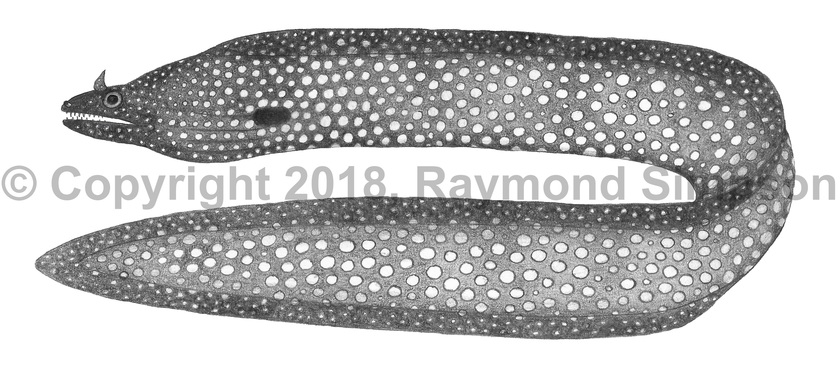
Common Name
Flagged Moray
Year Described
Richardson, 1845
Identification
Body elongate yet robust with well developed dorsal and anal finfolds. Trunk a little shorter than tail. Body thickest on anterior third. Head tapers anteriorly. Snout blunt. Jaw closes completely. A single row of fangs along anterior upper jaw and two rearward. A single row of 2-3 median intermaxillary fangs. Vomer with a row of small teeth. Lower jaw with a single outer row of fangs and a handful of larger fangs in an inner row. Anterior nostril is a small tube. Rear nostril a prominent flap extending well above head. Eye large. Throat region grooved. Gill opening a simple hole. Dorsal origin well anterior to gill opening. Fins confluent around tail.
Color
Body brown with closely spaced round white spots covering body and fins. Spots are smaller than eye diameter and interspaces are less than spot diameter. Spots become noticeably smaller on the anterior part of the head, making the snout appear darker than the rest of the body. A dark blotch surrounds gill opening. Eye body colored. Inside of mouth brownish. Posterior nostril dark with white spots. Juvenile with enlarged spots in clear rows.
Size
Maximum size to 67cm TL.
Habitat
Reef associated from 1-60m.
Range
Known from the southeastern Caribbean to Bahia State, Brazil. Also Fernando de Noronha and St. Paul's Rocks.
References
Feitoza, B.M., Rocha, L.A., Luiz-Júnior, O.J., Floeter, S.R., & J.L. Gasparini. 2003. Reef fishes of St. Paul’s Rocks: new records and notes on biology and zoogeography. aqua, 7(2), 61-82.
Júnior, J.G., Nóbrega, M.F., & J.E.L. Oliveira. 2015. Coastal fishes of Rio Grande do Norte, northeastern Brazil, with new records. Check List, 11(3), 1659.
Other Notes
This species is found sympatric with Muraena melanotis only on St. Paul’s Rocks in the W. Atlantic, from which is can be differentiated easily by the coloration of the snout.